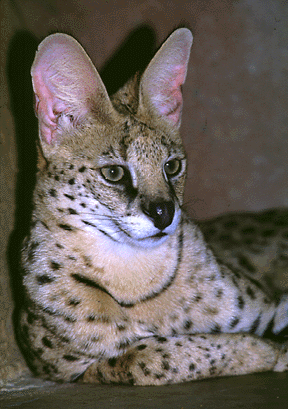SERVAL
Felis serval
MAMMAL
Order Carnivora
Description
2-3 ft long, tail length 10-17 in, 1.5-2
ft tall at shoulders, 20- 40 lbs. Males larger than females. Long-legged,
with a slender, sloping form, long neck, small head and very large oval
ears without ear tufts. Tawny or yellowish coat with variable dark
markings; lighter beneath. Tail has several rings and a black tip.
Range
Most of Africa, except very arid regions.
 Status
Status
One subspecies, the Barbary serval (F.s.
constantina) is listed as
endangered, and commercial trade is prohibited by international law. Other
members of the species are generally decreasing throughout the range; commercial
trade is regulated by international law, since it may become endnagered
without regulated trade. The serval is exploited for its fur and also persecuted
for its depredations on domestic fowl.
Photo by James p. Rowan Photography

 Ecology
Ecology
- Habitat
- savannas, reed-beds, open woodlands and forests,
normally
near water. - Niche
- carnivorous: eats small hoofed mammals, birds, rodents, insects and reptiles. It is a nocturnal and dirunal hunter, less nocturnal than many other small cats. Generally solitary. Mainly terrestrial, but is a good climber and will climb when threatened. Has great leaping ability, which enables it to flush out a bird on the ground and then catch it in the air before the bird can fly away. Stalks prey, followed by a short chase or leap. Vocalizations include a shrill cry, growls and purrs.
Life History
Mating nonseasonal; gestation about 75 days. Mother builds a form or den in tall, thick grass for babies. Litter size 1-4, avg 2-3. Newborns are blind. Can live in captivity to at least 13 years.
Special Adaptations
- Long legs and neck help in search of food, enabling the animal to see over tall grasses.
- Large ears help it to find prey; hearing is as important as sight in locating prey in the tall grass.
- Spotted coat breaks up body outline.
- Forepaws equipped with long, retractile claws to help grab and hold prey.
- Long, muscular limbs assist with high vertical
jumps and rapid jabs at prey with the forepaws.
